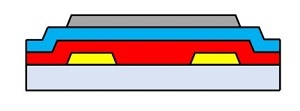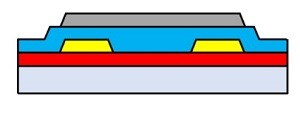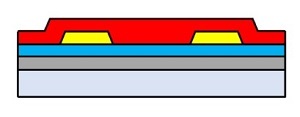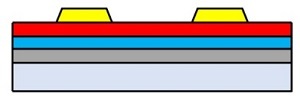
 Data Structure
Data Structure Networking
Networking RDBMS
RDBMS Operating System
Operating System Java
Java MS Excel
MS Excel iOS
iOS HTML
HTML CSS
CSS Android
Android Python
Python C Programming
C Programming C++
C++ C#
C# MongoDB
MongoDB MySQL
MySQL Javascript
Javascript PHP
PHP
- Selected Reading
- UPSC IAS Exams Notes
- Developer's Best Practices
- Questions and Answers
- Effective Resume Writing
- HR Interview Questions
- Computer Glossary
- Who is Who
TFT: Thin Film Transistor
Introduction
A Thin Film Transistor is a type of field-effect transistor that is usually used in a liquid crystal display(LCD). TFTs are arranged in a matrix which is why they are referred to as "active matrix"TFT. This type of display is where TFT is featured for each individual crystal. They perform as switches which enable the pixels to change their state rapidly which makes them turn on and off relatively quickly.
They have uses ranging from digital radiography detectors to displays that are used in daily use. These transistors are the driving force behind flat panel displays such as desktop computer screens, laptops, high definition televisions and even smartphones.
Design and Manufacturing
Design
TFTs are made by the process of layering a semiconductor and a dielectric active layer over a substrate .They also usually include metallic contacts such as a source material, drain metal and a gate layer.
The Substrate is usually made of glass and plastic.
The semiconductor is composed of Silicon,Cadmium selenide or other metal oxides.
The dielectric active layer consists of inorganic materials such as silicon oxide and silicon nitride.
-
The gate electrode is manufactured from polysilicon,TiN,WN or TaN
There are four different ways to layer the components and these ways alter the performance of the thin film transistor.
Top gate,Bottom contact

Top gate,Top contact

Bottom gate,Bottom contact

Top gate,Bottom contact

The colors in the above images are denoted as follows

Manufacturing
The Thin films are created after a deposition process in a vacuum chamber and are used mainly in the manufacturing of TFTs.
There are many methods for manufacturing TFTs but the most preferred processes are chemical vapor deposition and physical vapor deposition.
Thin films of polycrystalline or silicon in the amorphous state were historically employed in TFTs as semiconductors due to silicon's abundance in nature and widespread use in industry. However, scientists have found that amorphous silicon's poor mobility makes it unsuitable for TFTs , necessitating the use of alternative semiconductors.
The semiconductor must be deposited onto the substrate using a very specialized method in order to manufacture TFTs. TFTs, for instance, are quite susceptible to process temperature. Because several common substrates might melt at high temperatures, manufacturing must take place in low-temperature settings.
A few specialized methods are available for use by manufacturers to deposit semiconductors. The most popular ones are printing, chemical vapor deposition, atomic layer deposition, and spray coating. Solution-based techniques can provide more sophisticated substances that can be used in flexible electronics.Because the manufacturing process for thin-film transistors is so specialized, the materials and equipment used in labs to develop these transistors must also be specialized.
The Korvus HEX Series of thin deposition equipment offers the versatility, precision, and power necessary to create thin films. The HEX system's support for several deposition of thin film methods and procedures enables its flexibility in lab or research environments. Additional modules in the system allow for the customization of functionality.
The right systems are used to guarantee that TFTs have the required electrical performance, threshold voltage, operational stability, channel width, and transfer curves for the applications they are intended for.
Applications
Digital displays are the main application for thin transistor films. For instance, TFT layers used in AMOLED(active matrix organic light emitting diode)screens are produced using low-cost, low-temperature methods.
TFTs are now frequently found in a variety of digital detectors. It is used within the image receptors of digital radiography detectors used in medical radiography. TFTs are used in sensors as well as, including temperature, gas, and biological ones.
Head-up displays, which are crucial for driving and flying, could operate with transparent TFTs. Users with head-up displays can view information without changing their necessary vantage points.
Structure of TFT Display
Three main layers make up the TFT LCD's construction. Glass substrates make up the two sandwiching layers; one of them features TFTs, while the other has an RGB, or red, green, and blue, color filter. A liquid crystal layer is located in the space between the glass layers.
History
Thin Film Transistors are preceded by traditional metal-oxide-semiconductor field- effect transistors (MOSFETs).
Using germanium monoxide as the gate dielectric, John Wallmark of the Radio Corporation of America created a thin-film MOSFET in 1957. In 1962, Paul K. Weimer was able to produce the first thin-film transistor. The first thin film transistor (TFT) was made with a semiconductor made of a thin layer of cadmium selenide and cadmium sulfide.
Conclusion
Thin Film Transistors are a vital component of digital displays. In this article we learned about the design and manufacturing and the basic structure of a TFT based display. TFTs in displays have a wide range of applications because of its ability to work well with the change and management of pixels.
FAQs
Q1: What is MOSFET?
Ans: MOSFET is a metal oxide semiconductor field effect transistor.It is usually used to control conductivity i.e how much electricity flow is there between the drain terminals and the source.
Q2: What is chemical vapor deposition?
Ans: The technique known as chemical vapor deposition (CVD), a substrate is exposed to one or more volatile precursors, which then react or break down on the surface of the substrate to form the desired thin film deposit.
Q3: What is a transistor?
Ans: A transistor is a tiny semiconductor that regulates or controls the flow of current or voltage in addition to producing, amplifying, and functioning as a switch or gate for the electrical signals.

